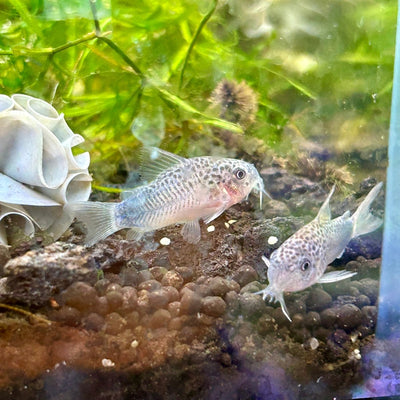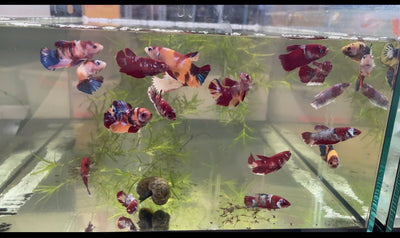Intro
Breeding betta probably the most excited fresh water breeding you can experience. Unlike most other fishes, breeding betta requires several steps and preparation. I also find it very rewarding to see successful spawn of eggs, hatching fries and growing up baby bettas. So I want to share my experience so hopefully you can be successful (because trust me it's very frustrated otherwise, all hardwork will be for nothing).
Its only been a year I tried breeding betta but I have bred over 10+ pairs, I have quite success recently. The most spawn I have is about 500 fries, but sometime I got a spawn with just dozen fries too.
First, we need a male and female
I assume you already know how to identify male and female betta. On most other breeding guide I found online, the first step of selecting male and female is very important and that's true. Having a great pair of betta will set you up for success, here are simple traits I hope to get for a nice breeding pair:
- Maturity: 5 months+ , but under 1 year. Ideally should be from 5-9 months.
- Size: bigger is better, male should be slightly bigger than female
- Active and healthy
Prepping the pair up
We want to feed them extensively for 5 days. For the female because we want her to be full of eggs, for the male because once he get in the process, he will need strength to chase the female and take care of the fries, this usually last 5-7 days and without food.
While prepping the pair, we should let them see each other at least few times a day.
Setting up breeding tank
This is probably most complicate part because everyone will have different setup. Here are some pros and cons I want to point out and what you should be consider:
- Small breeding box vs. Big breeding tank:
- Bigger your breeding tank will easily tired your male because it will be harder for him to chase the female
- Bigger your breeding tank will be harder for your male to tend to eggs, newly hatched fries.
- Smaller breeding box, sooner you need to transfer fries to grow out tank. This process is deadly if you don't have the water well prepare when transferring small fries.
- If you choose a glass tank, make sure to cover all sides.
- Both must have a lid to cover the top to create humidity so the bubble nest will stay up easily.
- Temperature:
- We want to have steady temperature, 80F is the sweetest spot, but fries still hatch at 74F up to 83F
- Avoid heater in tank that could damage betta fins when they chasing
- Live floating plant:
- This will serve as hiding spot for the female, and help process the water a little. Some say they provide food for newborn fries, but I'm not sure.
- Don't put hard decor, the chasing is intense so hard decor may increase the damage.
- I have floating Christmas moss, java fern, or floating type like fogbit or water lettuce
- Bubble nest spot:
- Leave some plastic wrap, bubble wrap or foam cup for the male to build bubble nest under.
- IAL is also good to condition water and betta could build nest under.
Here is some of my breeding setup:



If the condition allow, here is what I think and ideal setup to raise betta fries:
20 gallons tank with divider, setup the divider so that the breeding side is only 1/4 of the rest of the tank. So when the fries hatched, after removing the male we only need to remove the divider and don't need to worry about transferring fries. The breeding area is small enough for the pair to work out. Heater can be on the other side, and water parameters will be easier to control.
Breeding date
So you have a pair of betta ready, the breeding tank is all setup, now let get down to business:
- First put the male in (of course you need to follow step like you would for fish to a new tank). Allow the male sometimes ( at least an hour ) to settle in
- Introduce the female, put female inside transparent vase or cup and put inside the breeding tank, feed them both and leave them there for a few hours.
- Take out the female so the male can start work on bubble nest, reintroduce the female after 10 hours or so, of course continue to feed both of them
- Leave the female in vase/cup for one day. (I know it's taking forever and we just want to get right to it)
- If you see bubble nest then feed them one last time and start releasing the female. Observe them for few minutes and cover all side of the breeding tank, lid.
- Leave them alone until next day (after 24 hours)
- If no eggs after 24 hours, check if bubble nest still good, the pair still active and don't have a lot of damage on fins, body; then lets them work out another day. If you see bubble nest is destroyed or a lot damage on your betta then we should separate them and restart the process...
- If still no egg, separate them and restart process...
Eggs!!! What's next
Once they're done with business, the male will stay guard under the bubble nest while the female stay far away as she can in a corner or hiding behind leaves or plants. Then we need to proceed and remove the female.
Use scope and gently remove the female without much disturbing to bubble nest.
Now close the lid and wait for exactly 5 days after. Beginner mistake (like me ) will be opening the breeding box and check on the male tending to his nest several times a day.
After 5 days you should see fries free swim, the male will eat dead fries. How many fries you have will depend on how good is your male, some male will consistently able to tend to the nest of hundred of fries; helping them get to the bubble nest for air.
Now start removing the male (preferrably with hand to avoid scoping out fries)
YAY!!! You did it! You're now a betta breeder !! If you pass this step, you may need to check for next step: Raising betta Frys
I hope you have a spawn like this:

#betta, #breeding, #sellingbettaonline







1 comment
Big thanks for sharing Nick! I ve bred a lot of fish but continue to learn from everybody ! Cheers !